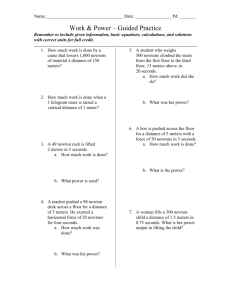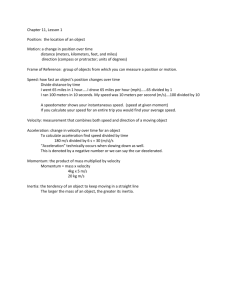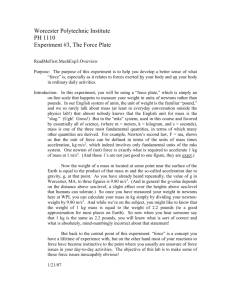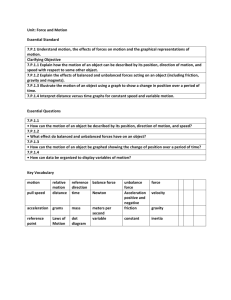RedLabExam
advertisement
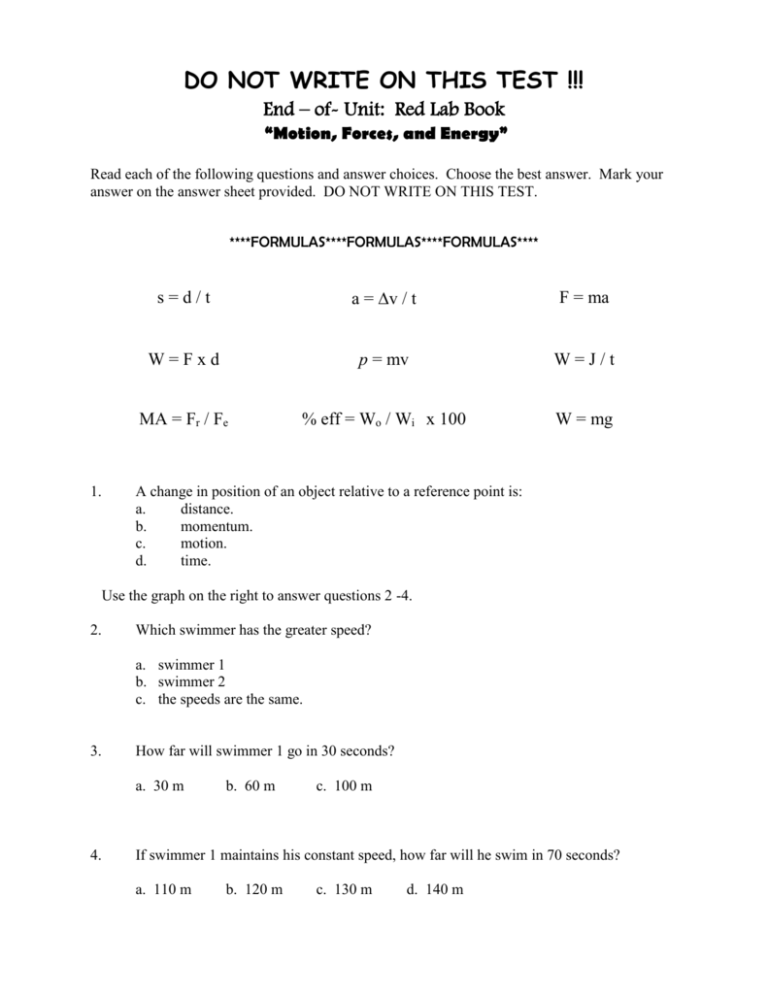
DO NOT WRITE ON THIS TEST !!! End – of- Unit: Red Lab Book “Motion, Forces, and Energy” Read each of the following questions and answer choices. Choose the best answer. Mark your answer on the answer sheet provided. DO NOT WRITE ON THIS TEST. ****FORMULAS****FORMULAS****FORMULAS**** 1. s=d/t a = v / t F = ma W=Fxd p = mv W=J/t MA = Fr / Fe % eff = Wo / Wi x 100 W = mg A change in position of an object relative to a reference point is: a. distance. b. momentum. c. motion. d. time. Use the graph on the right to answer questions 2 -4. 2. Which swimmer has the greater speed? a. swimmer 1 b. swimmer 2 c. the speeds are the same. 3. How far will swimmer 1 go in 30 seconds? a. 30 m 4. b. 60 m c. 100 m If swimmer 1 maintains his constant speed, how far will he swim in 70 seconds? a. 110 m b. 120 m c. 130 m d. 140 m 5. Choose the situation that describes an object with constant speed. a. A cop finds the speed of car with a radar gun. b. A driver looks down on the speedometer to see how fast he is going, then slows down. c. A driver sets the cruise control on his car. d. A student tells her friend that her family traveled about 55 mph on their family trip to Cleveland. 6. Choose the situation that describes an object with instantaneous speed. a. A cop finds the speed of car with a radar gun. b. A driver looks down on the speedometer to see how fast he is going, then slows down. c. A driver sets the cruise control on his car. d. A student tells her friend that her family traveled about 55 mph on their family trip to Philadelphia. 7. What is the speed of an object that takes 20 seconds to travel 1000 meters? a. 50 m/s b. 50 m/s2 c. 20,000 m/s d. 20,000 m/s2 8. Which has more momentum: a 6kg bowling ball rolling at 2 m/s or a 0.5kg baseball hit at 50 m/s? a. bowling ball b. baseball c. neither have momentum d. both have equal momentum 9. What is the unit of speed? a. meters b. meters/second c. meters/second2 d. seconds 10. An object is accelerating when it: a. changes velocity. b. slows down. c. speeds up. d. all of the above. 11. Choose the situation that describes an object with positive acceleration. a. A student sits quietly in class waiting for directions. b. A car comes to rest at a stop sign. c. A snowboarder gains speed as she slides down the snowy hill. d. A roller coaster comes to rest in the station. 12. Choose the situation that describes an object with negative acceleration. a. An 8th grader runs across the room to answer the phone. b. A car gains speed as the driver tries to pass another car. c. A snowboarder gains speed as she slides down the snowy hill. d. A roller coaster comes to rest in the station. Use the following graph to answer questions13 through 15. Distance Distance vs Time 10 8 6 4 2 0 0 1 2 3 4 5 6 7 8 9 10 11 12 Time 13. The plateau on the graph indicates that the object is: a. positively accelerating. b. moving at a constant speed. c. negatively accelerating (decelerating). d. stopped. 14. Either sloped line on the graph indicates that the object is: a. accelerating. b. moving toward the starting point at a constant speed. c. moving away from the starting point at a constant speed. d. stopped. 15. The y-axis of this graph should be labeled with: a. meters b. meters/second c. meters/second2 d. seconds 16. What is the acceleration of an object that starts from rest and is traveling at 80 m/s after 4 seconds? a. 20 m/s b. 20 m/s2 c. 320 m/s2 d. 320 m/s 17. The acceleration due to gravity (on Earth) is a. 98 m/s b. 9.8 m/s2 c. 0.98 m/s2 d. 9.8 m/s Use the following graph to answer questions 18 through 20. Speed Speed vs Time 10 8 6 4 2 0 0 1 2 3 4 5 6 7 8 9 10 11 12 Time 18. The plateau on the graph indicates that the object is: a. positively accelerating. b. moving at a constant speed. c. negatively accelerating (decelerating). d. stopped. 19. Either sloped line on the graph indicates that the object is: a. accelerating. b. moving backward at a constant speed. c. moving forward at a constant speed. d. stopped. 20. The y-axis of this graph should be labeled with: a. meters b. meters/second c. meters/second2 d. seconds 21. All of the following are types of forces except: a. a person’s weight. b. friction. c. light from the sun. d. the push of a button. 22. What is the unit of power? a. grams b. Joules c. Newtons d. Watts 23. There is only 1 cone of Chunky Munky left on Ben & Jerry’s free cone day. Jack and Jill both have their hands on it, and are pulling in opposite directions. Jack pulls with a force of 15 N to the right, and Jill pulls with a force of 17 N to the left. What is the final, net force on the ice cream cone? a. 32 N to the right c. 2 N to the right b. 32 N to the left d. 2 N to the left 24. An 80 kg football player is tackled and sent flying to the ground at an acceleration of 50 m/s/s. What force was he hit with? a. 4000 Newtons b. 1.6 Newtons c. 4000 m/s d. 30 Newtons 25. Choose the type of friction involved when a child pulls his wagon. a. fluid b. rolling c. sliding d. none of the above 26. Choose the type of friction involved when a diver does a swan dive into a pool. a. fluid b. rolling c. sliding d. none of the above 27. How can you reduce the amount of friction acting on an object? a. Add more mass. b. Attach a spring scale. c. Use a lubricant. d. Use a surface that is rougher. For questions 28 through 35 use the following choices: a. First b. Second c. Third 28. Which of Newton’s 3 Laws explains why a rocket is sent up into space by an explosion that shoots out the bottom? 29. Which of Newton’s Three Laws explains why a rubberband that is pulled backwards will shoot forward when released? 30. Which of Newton’s Three Laws states that “When a net force is applied to an object, it will accelerate in the direction of the force”? 31. Which of Newton’s three laws states that “For every action there is an equal and opposite reaction”? 32. Which of Newton’s three laws states that that “An object has a tendency to resist any change in its motion”? 33. Which of Newton’s three laws explain why you bounce higher off of the trampoline when you jump harder? 34. Which of Newton’s three laws is the reason that seat belts and air bags were invented? 35. Which of Newton’s three laws explains why it is harder to push a full grocery cart than an empty grocery cart? 36. What is the unit of work? a. grams b. Joules c. Newtons d. Watts 37. Using an inclined plane to raise a box requires more work. Why? a. Work is spread out over a shorter distance. b. More force must be used to lift the object. c. Using an inclined plane actually reduces the amount of work. d. Less force is used over a longer distance, creating more work. 38. Why do we use simple machines? a. To make the amount of work seem easier. b. To make the amount of work seem harder. c. To reduce the amount of distance moved (effort distance). d. To reduce the amount of work done. 39. Which of the following is NOT work? a. Carrying a heavy tray of meals to the table. b. Picking up a book from the floor. c. Lifting a child while babysitting. d. Pushing a shopping cart. 40. Refer to the data table to the right. Four students each lift a 2000 N object 3m into the air. Which of the students had the most power? a. Austin b. Carson c. Mike d. Tyler Student Austin Carson Mike Tyler Time to lift object 2 min 3 min 2.1 min 2.8 min 41.All of the following quantities depend upon time except a. work b. speed c. power d. acceleration 42. A motor changes ____________ energy into ____________ energy. a. chemical; mechanical b. electrical; mechanical c. mechanical; electrical d. mechanical; radiant 43. A generator changes ____________ energy into ____________ energy. a. chemical; mechanical b. electrical; mechanical c. mechanical; electrical d. mechanical; radiant 44. When an electric current is sent through a coil of wire a a battery is created. b. you always get shocked c. a generator is created. d. a magnetic field is created. 45. The picture shows how to make an electromagnet. Which of these would make the electromagnet strongest? a. Using a longer wire from the battery to the nail b. Wrapping the wire around the nail more times c. Wrapping the wire around a non-metal object d. Making the loops of wire less tightly coiled. 46. The watt is named for James Watt. Watt invented the first steam engine and was hoping to get rich. To advertise his invention, he compared its power to that of a horse. A horse can lift 2475 N a distance of 0.3 m in 1 second. How much power does the horse have? (This is known as horsepower, a unit frequently used in reference to cars.) a. 742.5 J b. 8250 J C. 742.5 W d. 8250 J
